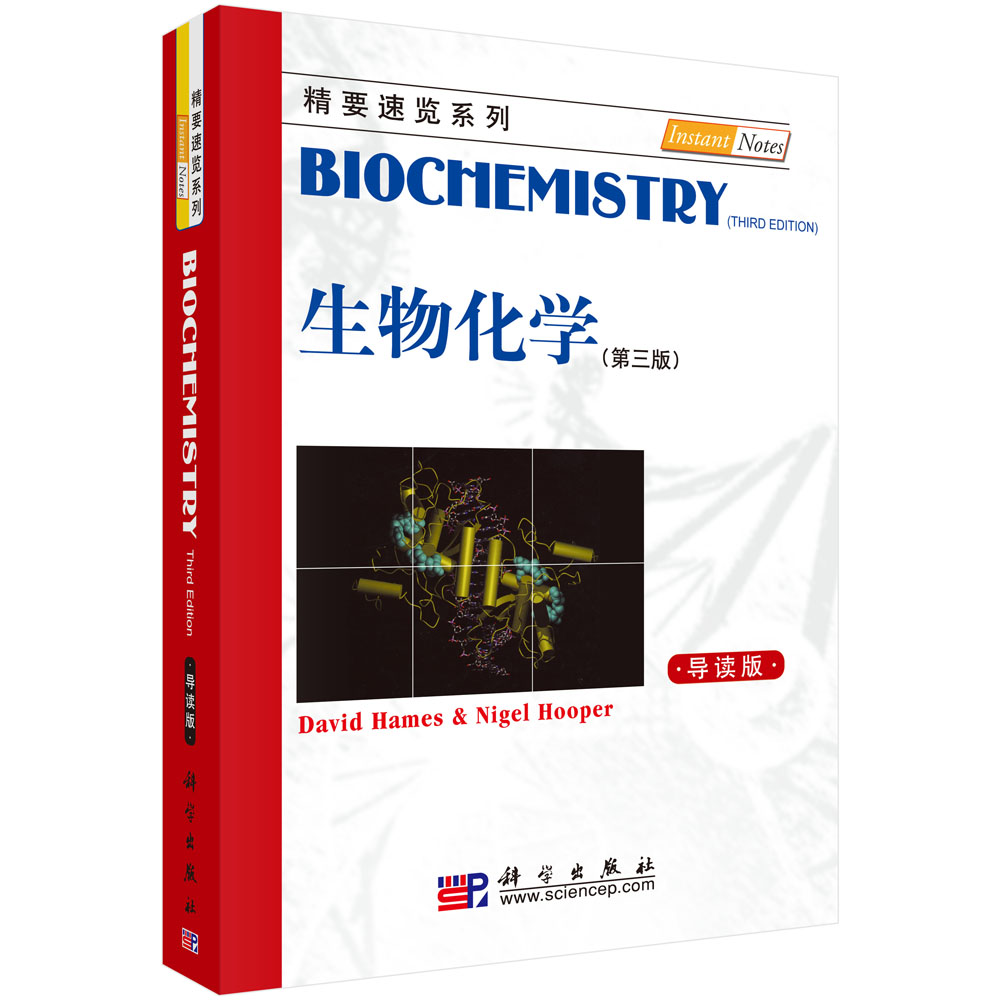
出版社: 科学
原售价: 88.00
折扣价: 79.20
折扣购买: 生物化学(第3版导读版)/精要速览系列
ISBN: 9787030252180

A1 PROKARYOTE CELL STRUCTURE
Key Notes
Prokaryotes Prokaryotes are the most abundant organisms on earth and fall into two distinct groups, the bacteria (or eubacteria) and the archaea (or archaebacteria).A prokaryotic cell does not contain a membrane-bound nucleus.
Cell structure Each prokaryotic cell is surrounded by a plasma membrane.The cell has no subcellular organelles, only infoldings of the plasma membrane called mesosomes.The deoxyribonucleic aad (DNA) is condensed within the cytosol to form the nucleoid.
Bacterial cell walls The peptidoglycan (protein and oligosaccharide) cell wall protects the prokaryotic cell from mechanical and osmotic pressure.Some antibiltics, such as penicillin, target enzymes involved in the synthesis of the cell wall.Gram-positive bacteria have a thick cell wall surrounding the plasma membrane, whereas Gram-negative bacteria have a thinner wall and an outer membrane, between which is the periplasmic space.
Bacterial flagella Some prokaryotes have tail-like flagella.By rotation of their flagelk bacteria can move through their surrounding media in response to chemicals (chemotaxis).Bacterial flagella are made of the protein flagellin that forms a long filament which is attached to the flagellar motor by the flagellar hook.
Related topics Eukaryote cell structure (A2)
Cytoskeleton and molecular motors (A3)
Amino aads (Bl)
Membrane lipids (El)
Membrane proteins and carbohydrate (E2)
Genes and chromosomes (F2)
Electron transport and oxidative phosphorylation (L2)
Prokaryotes
Prokaryotes are the most numerous and widespread organisms on earth, and are so classified because they have no defined membrane-bound nucleus.Prokaryotes comprise two separate but related groups: the bacteria (or eubac- teria) and the archaea (or archaebacteria).These two distinct groups of prokary- otes diverged early in the history of life on Earth.The living world therefore has three major divisions or domains: bacteria, archaea and eukaryotes (see Topic A2).The bacteria are the commonly encountered prokaryotes in soil, water and living in or on larger organisms, and include Escherichia coli and the Bacillus species, as well as the cyanobacteria (photosynthetic blue-green algae).The archaea mainly inhabit unusual environments such as salt brines, hot aad springs, bogs and the ocean depths, and include the sulfur bacteria and the methanogens, although some are found in less hostile environments.
Cell structure
Prokaryotes generally range in size from 0.1 t0 10 Um, and have one of three basic shapes: spherical (cocci), rod-like (bacilli) or helically coiled (spirilla).Like all cells, a prokaryotic cell is bounded by a plasma membrane that completely encloses the cytosol and separates the cell from the external environment.The plasma membrane, which is about 8 nm thick, consists of a lipid bilayer containing proteins (see Topics El and E2).Although prokaryotes lack the membranous subcellular organelles characteristic of eukaryotes (see Topic A2), their plasma membrane may be infolded to form mesosomes (Fig.1).The meso- somes may be the sites of deoxyribonucleic aad (DNA) replication and other specialized enzymatic reactions.In photosynthetic bacteria, the mesosomes contain the proteins and pigments that trap light and generate adenosine triphosphate (ATP).The aqueous cytosol contains the macromolecules [enzymes, messenger ribonucleic aad (mRNA), transfer RNA (tRNA) and ribo- somes], organic compounds and ions needed for cellular metabolism.Also within the cytosolis the prokaryotic 'chro.mosome' consisting of a single circular molecule of DNA which is condensed to form a body known as the nucleoid (Fig.1) (see Topic F2).
Bacterial cell walls
To protect the cell from mechanical injury and osmotic pressure, most prokary- otes are surrounded by a rigid 3-25 nm thick cell wall (Fig.1).The cell wall is composed of peptidoglycan, a complex of oligosaccharides and proteins.The oligosaccharide component consists of linear chains of alternating N-acetylglu-cosamine (GlcNAc) and N-acetylmuramic acid (NAM) linked p(l-4) (see Topic J1).Attached via an amide bond to the lactic acid group on NAM is a D-amino acid-containing tetrapeptide.Adjacent parallel peptidoglycan chains are cova- lently cross-linked through the tetrapeptide side-chains by other short peptides.The extensive cross-linking in the peptidoglycan cell wall gives it its strength and rigidity.The presence of t)-amino aads in the peptidoglycan renders the cell wall resistant to the action of proteases which act on the more commonly occurring L-amino acids (see Topic Bl), but provides a unique target for the action of certain antibiotics such as peniallin.Penicillin acts by inhibiting the enzyme that forms the covalent cross-links in the peptidoglycan, thereby weak- ening the cell wall.The p(l-4) glycosidic linkage between NAM and GlcNAc is susceptible to hydrolysis by th